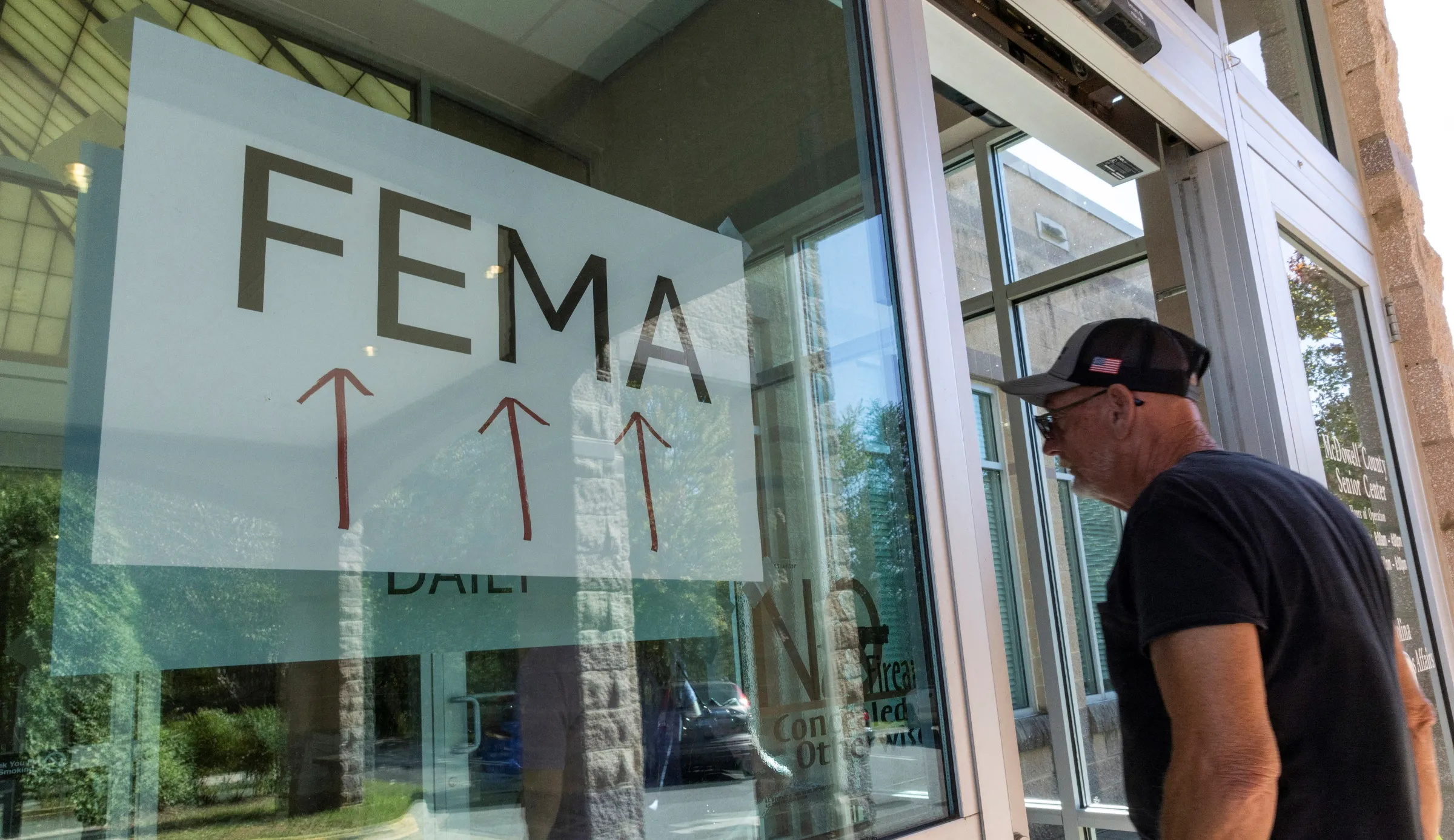20 years after Hurricane Katrina, can FEMA weather Trump?

A resident enters a FEMA's improvised station to attend claims by local residents affected by floods following the passing of Hurricane Helene, in Marion, North Carolina, U.S., October 5, 2024. REUTERS/Eduardo Munoz
What’s the context?
FEMA staffers warn agency cuts could lead to repeat of Katrina aftermath.
RICHMOND, Virginia - As the U.S. marks the 20th anniversary of Hurricane Katrina, more than 180 current and former Federal Emergency Management Agency (FEMA) staffers warn cuts and leadership failures at the agency could lead to another calamitous disaster response.
In August 2005, Katrina killed nearly 1,400 people and caused an inflation-adjusted $205 billion in damages to become the most destructive hurricane in U.S. history.
This past year, the United States has suffered a record run of hurricanes, wildfires and storms this past year, including the recent Texas floods in July, shining a renewed spotlight on the federal department that is tasked with handling ever more natural disasters.
President Donald Trump issued an executive order dated Jan. 24 calling for a review of FEMA, which is challenged by disasters that strike more frequently and powerfully in a fast-changing climate.
Trump has even said he might like to see FEMA disbanded entirely.
Here's what to know about FEMA under Trump:
What does the letter from current and former staffers say?
The letter from FEMA staff to Congress, released publicly on Aug. 25, criticised FEMA leadership, along with Homeland Security Secretary Kristi Noem, saying agency decisions have eroded its ability to carry out its mission.
The signatories wrote that they oppose cost-cutting measures, "interference with preparedness programmes" like the National Fire Academy, censorship of climate science, and reducing the agency's disaster workforce.
The authors wrote they hope their statements and petition to Congress "come in time to prevent, not only another national catastrophe like Hurricane Katrina, but the effective dissolution of FEMA itself and the abandonment of the American people such an event would represent."
Mark Bove, a meteorologist with the German reinsurer Munich Re, warned in a new study that the U.S. Gulf Coast was increasingly vulnerable to hurricanes.
The scientist warned the risk of major hurricanes in the region making landfall was growing with time and the effectiveness of post-Katrina flood defence systems would fade.
How is FEMA responding?
In response to the letter, a Department of Homeland Security (DHS) spokesperson defended the administration's work, saying Americans "deserve better than the slow, inadequate disaster responses of the past".
"It is not surprising that some of the same bureaucrats who presided over decades of inefficiency are now objecting to reform," said the spokesperson for DHS, which is FEMA's parent agency.
"Change is always hard. It is especially for those invested in the status quo. But our obligation is to survivors, not to protecting broken systems."
What might happen if FEMA shut up shop?
Trump cannot unilaterally end FEMA via executive order; getting rid of the agency would instead need an act of Congress.
But as climate change fuels ever more billion-dollar disasters, residents, states and localities could be forced to cope solo in the run-up to and aftermath of any danger, experts say.
"If we abolish federal funding for disaster assistance, municipalities and states wouldn't be able to cover these types of catastrophic emergencies and people would be left to fend on their own," said Shana Udvardy, an analyst at the Union of Concerned Scientists advocacy group.
Beyond disaster response, FEMA also helps states prepare for disasters - work the public might not be aware of, said Rob Moore with the Natural Resources Defense Council (NRDC).
"There's all kinds of other things that happen in the background we don't see," he said.
FEMA's reputation has struggled to recover after its poor handling of Katrina, which made landfall along the U.S. Gulf Coast on August 29, 2005.
What else could be affected without FEMA?
FEMA administers the National Flood Insurance Program (NFIP), which had close to 4.7 million policies providing almost $1.3 trillion in coverage as of the end of 2024.
FEMA also sets national standards for building codes and standards in floodplains, and its flood risk mapping helps guide construction countrywide, Moore noted.
"FEMA has an even larger role on flood disasters than it does elsewhere," he said.
States already request help from FEMA when disasters stretch agencies beyond their ability to respond, Moore said.
"I haven't heard a lot of states clamouring for FEMA to leave them alone and not come to their assistance. Maybe I've missed those stories," he said.
This article was updated on August 26, 2025 to include the latest developments.
(Reporting by David Sherfinski and Carey L. Biron; Editing by Lyndsay Griffiths, Anastasia Moloney, and Ana Nicolaci da Costa.)
Context is powered by the Thomson Reuters Foundation Newsroom.
Our Standards: Thomson Reuters Trust Principles
Tags
- Extreme weather
- Climate policy
- Climate solutions



















